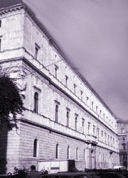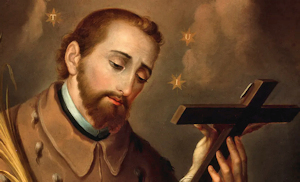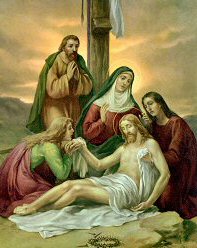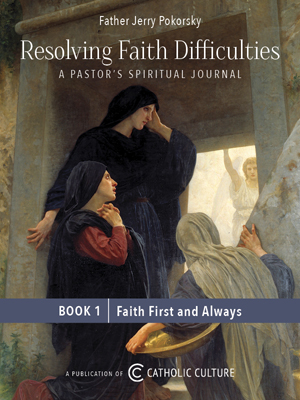Lent: March 20th
Tuesday of the Fourth Week of Lent
Other Commemorations: St. John Nepomucene, Priest and Martyr (RM)
» Enjoy our Liturgical Seasons series of e-books!
One man was there who had been ill for thirty-eight years. When Jesus saw him lying there and knew that he had been ill for a long time, he said to him, "Do you want to be well?" The sick man answered him, "Sir, I have no one to put me into the pool when the water is stirred up; while I am on my way, someone else gets down there before me." Jesus said to him, "Rise, take up your mat, and walk." Immediately the man became well, took up his mat, and walked (Jn 5:5-9).

The Station today is in St. Lawrence's in Damaso—a church built by Pope St. Damascus in honor of the martyred deacon. It was one of the first parish churches in Rome and was rebuilt in the late 15th century by Bramante, and has since been restored several times. Pope St. Damasus' relics are beneath the altar. Today the church is part of the Cancelleria, or the chancery, and houses the Holy Father's Tribunals: the Roman Rota, Apostolic Signatura, and Apostolic Penitentiary.
Meditation - The Just Man Shall Fall Seven Times
"The just man shall fall seven times, and shall rise again; but the wicked shall fall down into evil" (Prov. 24:16). The characteristic of real wickedness is to fall "down, into evil"-that is, to fall and then consciously and obstinately to remain fallen. Yet, is it not comparative wickedness to fall even into venial sins with such interior dispositions as will not permit the sinner to rise again promptly?
Mark well, the distinguishing trait of the just man is not his absolute freedom from every fall, but rather his entire and quick readiness to rise again-the honest interior disposition which bars out all malice, all settled bad will, and all affection for his wrongdoings; the penitent disposition which will accomplish this so effectually, that his later sins will be committed only in more or less unguarded moments of special weakness or surprise or fickleness, and therefore with only partial freedom and consent of his will. Even so effectually will he guard himself that after a sin, however slight, he will quickly return to his normal virtuousness, acknowledge his guilt, fill his heart and soul with sincere remorse, and then and there long and pray to become more truly humble and less self-reliant, more watchful over himself and quicker in his recourse to God. 0 the shame of your relapses, so many altogether inexcusable! The shame of your repeated relapses, habitual relapses, some perhaps clear evidence of more or less hardness of heart and malice of will! O the shaming thought of the piercing truth: If you had sinned less, Jesus would have suffered less!
Excerpted from Our Way to the Father, Rev. Leo M. Krenz, S.J.
Things to Do:
- If you have not done so already, read the Message of Pope Benedict XVI for Lent of 2006.
- Cook a traditional Lenten recipe to reemphasize this liturgical season in the daily fare of your home. We suggest Split Pea Soup.
St. John Nepomucene (Nepomuk)
 Born at Nepomuk, Bohemia, 1340; died in Prague, March 20, 1393; canonized in 1729. Saint John used the name of his native town for his surname instead of his family name of Woelflein or Welflin. He studied at the University of Prague, was ordained, and became a canon. In time, he became vicar general of Archbishop John of Genzenstein at Prague and according to tradition incurred the enmity of dissolute King Wenceslaus IV when he refused to reveal what Queen Sophie, Wenceslaus’ second wife, had told him in confession. Of a retiring disposition, Father John repeatedly refused bishoprics which were offered to him.
Born at Nepomuk, Bohemia, 1340; died in Prague, March 20, 1393; canonized in 1729. Saint John used the name of his native town for his surname instead of his family name of Woelflein or Welflin. He studied at the University of Prague, was ordained, and became a canon. In time, he became vicar general of Archbishop John of Genzenstein at Prague and according to tradition incurred the enmity of dissolute King Wenceslaus IV when he refused to reveal what Queen Sophie, Wenceslaus’ second wife, had told him in confession. Of a retiring disposition, Father John repeatedly refused bishoprics which were offered to him.
In 1393 (or 1383 according to some), he became involved in a dispute between Wenceslaus and the archbishop when the king sought to convert a Benedictine abbey into a cathedral for a new diocese he proposed to create for a favorite when the aged abbot died. The archbishop and John thwarted him by approving the election of a new abbot immediately on the death of the old abbot. At a meeting with John and other clerics, Wenceslaus flew into a rage, tortured them so that John was seriously injured, and then had him murdered and thrown into the Moldau River at Prague (Attwater, Benedictines, Delaney).
Saint John is portrayed in art as an Augustinian canon with a fur almuce and a bridge near him. He may hold his finger to his lips and have seven stars around his head, or wear a padlock on his lips (in Austria and Bohemia). John, patron of confessors and bridges, is venerated in Austria and Spain (Roeder).
—by Katherine Rabenstein, Saints of the Day
Patronage: against calumnies; against floods; against indiscretions; against slander; bridge builders; bridges; canons; confessors; for discretion; for good confession; mariners, sailors, boatmen, watermen; running water; silence; spiritual directors; Bohemia; Czech Republic; archdiocese of Prague, Czech Republic; Slovakia; Venice, Italy
Symbols and Representation: halo with five stars; cross; bridge; angel indicating silence by a finger over the lips; priest's biretta
Highlights and Things to Do:
- Read more about St. John Nepomucene:
- Read about the location of Saint John of Nepomuk's Martyrdom.
- The Statue of St. John of Nepomuk on Charles Bridge in Prague.
- See Christian Iconnography for depictions of St. John.
- Learn more about Prague and the Czech Republic and St. Vitus Cathedral, supposedly started by St. Wenceslas in the 10th century as a small chapel to house relics of St. Vitus and were in the 14th century St. John Nepomucene was buried after being executed for refusing to violate the seal of the confessional.
- Read about the Infant Jesus of Prague and pray the chaplet.
- Bake a loaf of bread for dinner and serve Pilsner beer in honor of St. Wenceslas. See also Catholic Cuisine for other ideas.






